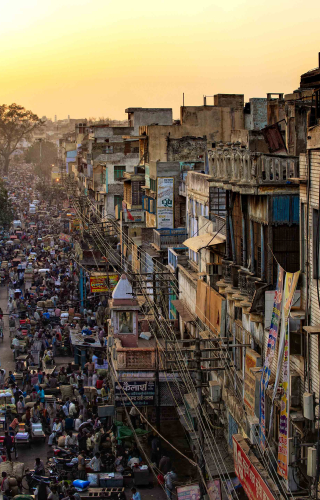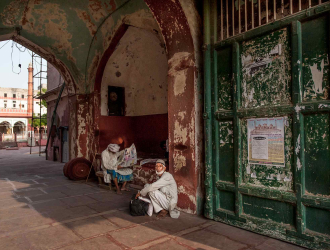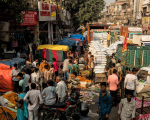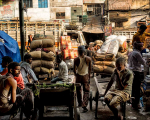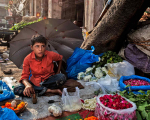Khari Baoli is a space of many textures, colours, sounds and aromas. The streets are continuously chaotic—trucks and carts blocking the road, traders haggling, labourers hauling, pulling and dragging sacks, and the aroma of spices burning the nostrils. This richness of life has been the backdrop to many interesting portraits I have shot there. Hence, this photo essay, apart from tracing the history of the spice market, also investigates visions of a place tinted by the exultation of the human spirit—joie de vivre of the working class.
Khari Baoli is even older than the city of Shahjahanabad, built as an imperial capital by Shah Jahan in the first half of the 17th century. Unfortunately, the baoli (stepwell), the namesake of the neighbourhood, has long since vanished. It got its name from the brackish (khada) water which was unfit for drinking, but was used for purposes of bathing and washing. With the changing dynamics of Delhi’s history, the region developed into a thriving spice market, indeed the largest in Asia, and new buildings emerged to replace the old Mughal architecture. The spice market is now based in and around Gadodia Market, built sometime in the 1920s. The mansion was named after its owner Mr L.L. Gadodia, who emigrated to the United States about sixty years ago.
Though the building looks distinctly European, the ornamentation, such as chhajjas and chhatris, boasts of a strong Hindu influence. Was the building inspired by Lutyens’ style, who was designing New Delhi at the same period, located just a few kilometres to the south of Shahjahanabad? Why, despite its present dilapidated condition, has it not been converted into a heritage site and made free of encroachment? Answers, I have none, but I do hope that someday some academic will take a deeper interest and discover the forgotten history of Gadodia Market.
A visit to the roof of the building allows an impressive view of the central courtyard and the adjoining Khari Baoli bazaar. On the eastern side of Gadodia Market stands the Fatehpuri Masjid, completed in 1650, and predictably Mughal in design. However, there is hardly any remnant of the Mughal era anywhere else in the area. Instead the buildings here are living examples of a syncretic style of architecture—a seamless mix of the European influences from the Victorian, Edwardian and Georgian periods with Indian architectural elements. In Khari Baoli, everywhere you look there is juxtaposition of contrasting elements—colonial vs Mughal, grandeur vs decay, human labour vs architectural decadence, light vs shadow, order vs chaos, and so on.
The Gadodia Market is an example of how humans interact with spaces and how their usage change over time. It is a visually exciting experience for anyone interested in comparing the mansion’s colonial past and its subsequent ‘evolution’ as a spice warehouse. Despite the current state of decline, Khari Baoli had always been a habitation space for generations of traders who own shops and warehouses here and the transient labourers and customers who come and go on a daily basis. In recent times Gadodia Market has found a new audience in tourists, heritage enthusiasts and photographers like me, who have discovered this place as part of heritage walks conducted in the old city. From the rooftop, visitors get a view of the Red Fort, Jama Masjid, the adjoining Fatehpuri Masjid and observe daily life unfolding, kabootarbaazi (pigeon fighting) and kite flying. In the streets below they experience the eccentric hustle of a marketplace where no trader has a second to spare if you are not interested in buying anything from them. I hope someday the apathy of the local stakeholders towards Gadodia Market will turn to empathy, and the place will be restored to its past glory. As a photographer‒voyeur, my interaction with the space will continue to evolve, and I will keep coming back to the Gadodia Market because there is a sense of predictability in its ability to be unpredictable!
